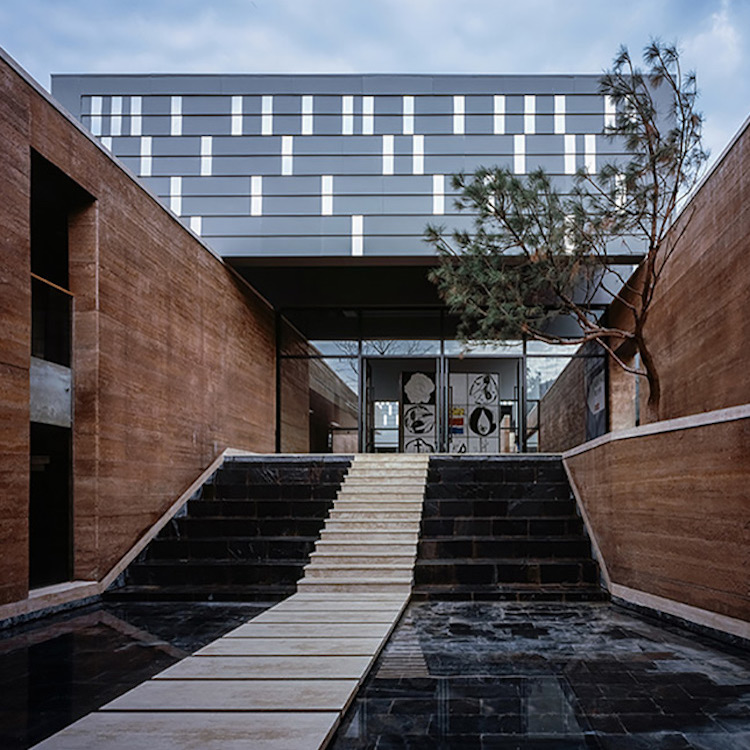BEIJING—This week we bring you not one, but two Chinese art museums, each utilizing ceramic in distinctively divergent routes.
Beijing-based DL Atelier designed a museum for the city of Jingdezhen—China’s porcelain capitol. The museum will not only house the work of China’s historic and contemporary porcelain artists, but also features a geometric—almost ritualistic— articulation of concrete form buried beneath the earthy strata of its encasing loam walls formed from local clay.
The building, presumed to be in stark artificiality of the flowing pools water and organic plants, rather, seamlessly exists in harmonic juxtaposition. The architects tell DesignBoom: “Like a scene from 2001: A Space Odyssey, a huge artificial creation buried in the natural background for years.”
From an exterior view, the linear, geometric architecture implies a deliberate circulation plan, but instead the architects created an overall, serendipitous, labyrinth-like progression through the space.
From a pair of architects who say they believe “great design is all about feelings and memories,” this museum feels like a familiar memory I’ve yet to experience. Imbuing a sense of meditative calm and stillness, my anxious-by-default mind is effortlessly quiet. DesignBoom writes this feeling is by design, affording visitors more freedom to explore and draw individual conclusions of what they are perceiving.
Lacking the traditional flow found in most museum designs, the architects experimented with the relationship between the space, art, and the viewer. Without the implied progression and circulation it becomes a more freeform experience.
Further expanding on their design, they architects explain ‘the museum is a visually linear shape, 150 meters long, but the visiting flow is actually nonlinear, visitors will have multiple choices to go. The purpose is to boost serendipities between people and spaces, we believe architecture can create the atmosphere with which visitors will have personal connections. once built, exhibited items will no long be important, they will act like mirrors, visitors will be reviewing themselves through these items. I believe true arts are the medium to help ourselves to see the true version of ourselves, sometimes clear, others vague, sometimes real, others fake.’
The building was constructed with the implication that, over time, the building materials themselves, like the rammed earth and titanium zinc panels, will age, with its integrity remaining intact.
“[Like] the fermentation of wine, where time gives it a unique flavor” —DL Atelier
On the other side of the spectrum is the Red Brick Art Museum located in the International Art District on northeast Beijing. Formed of imposing red brick clad walls, stairs, floors and railing. ArchDaily writes architect Dong Yugan created a structure that is, itself, a piece of art.
The perforations, skylights and narrow windows manipulate light into the spaces, casting dramatic shadows and offering short glimpses outside.
The detail in the brick alone is astonishing. The myriad wall structures feature haptic textured pattern at some places and a more traditional bond of alternating headers and stretchers in others. The large aperture pictured below is finished off by a perfectly rounded rowlock. I’m sure you ceramophiles could add a few more brick pattern sightings to this list. But you get the picture.
The grey-ish tone and linear sky-lighting at the entrances guides visitor through a corridor to the main hall featuring a subterranean circular arena. Situated above the space is an oculus skylight penetrating the height of the two-story structure.
[The] building holds 9 exhibition spaces, 2 public recreation areas, a lecture hall, dining room, café and various other facilities, set above 3 screening rooms occupying the basement. The entire facilities cover a footprint of 20,000 square meters, of which 10,000 square meters is dedicated to the exhibits.
Jingdezhen images by Sun Haiting; Red Brick Art Museum images courtesy Don Yugon Brick Museum
Do you love or loathe these examples of ceramic architecture from the world of contemporary ceramic art and contemporary ceramics. Let us know what you think in the comments section below.

















Add your valued opinion to this post.